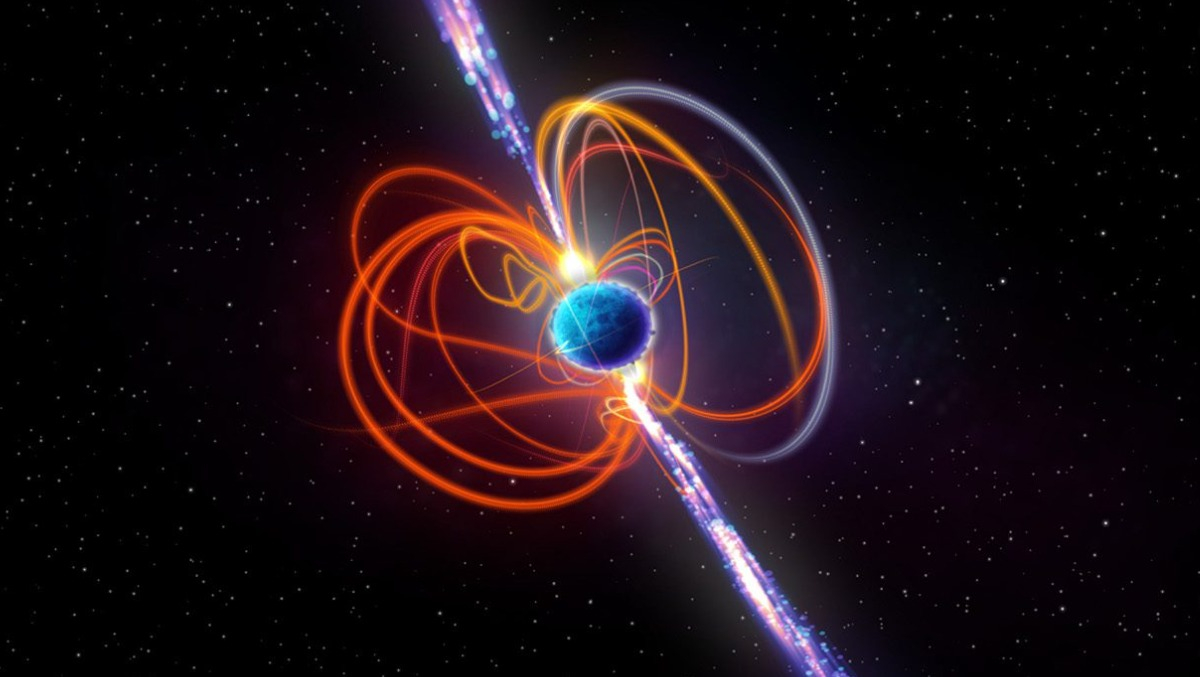The team, led by Dr Natasha Hurley-Walker, believe the object could be an ultra-long period magnetar, a rare type of star with powerful magnetic fields that can produce powerful bursts of energy.
Researchers made the discovery using the MWA telescope in Western Australia before it was subsequently corroborated by telescopes in South Africa and Spain, as well as the XMM-Newton telescope in space.
The apparent magnetar, now named GPM J1839−10, is 15,000 light-years away from Earth in the Scutum constellation.
Dr Natasha Hurley-Walker will be appearing on the next episode of the Space Connect Podcast to talk about the discovery.
“This remarkable object challenges our understanding of neutron stars and magnetars, which are some of the most exotic and extreme objects in the universe,” Dr Hurley-Walker said.
Neutron stars are the collapsed cores of massive stars that have exploded as supernovae. They are incredibly dense, with the mass of the sun squeezed into a sphere about 20 kilometres across.
They also have extremely strong magnetic fields, trillions of times stronger than the Earth’s.
Magnetars, meanwhile, are a type of neutron star with even stronger magnetic fields and can emit bursts of high-energy radiation, including X-rays and gamma rays.
Curtin University undergraduate research student Tyrone O’Doherty discovered the first stellar object.
O’Doherty and the team he was in published a paper in Nature in January 2022 describing the enigmatic transient object that would intermittently appear and disappear, emitting powerful beams of energy three times per hour.
Dr Hurley-Walker – O’Doherty’s honours supervisor – said it took her team by surprise.
“We were stumped,” she said. “So we started searching for similar objects to find out if it was an isolated event or just the tip of the iceberg.”
Between July and September 2022, the team scanned the skies using the MWA telescope and soon found the second example.
GPM J1839−10, however, emits bursts of energy that last up to five minutes – five times longer than the first object.
Other telescopes followed up to confirm the discovery and learn more about the object’s unique characteristics.
Armed with GPM J1839−10’s celestial coordinates and characteristics, the team also began searching the observational archives of the world’s premier radio telescopes.
“It showed up in observations by the Giant Metrewave Radio Telescope (GMRT) in India, and the Very Large Array (VLA) in the USA had observations dating as far back as 1988,” she said.
“That was quite an incredible moment for me. I was five years old when our telescopes first recorded pulses from this object, but no one noticed it, and it stayed hidden in the data for 33 years. They missed it because they hadn’t expected to find anything like it.”
Not all magnetars produce radio waves. Some exist below the “death line”, a critical threshold where a star’s magnetic field becomes too weak to generate high-energy emissions.
“The object we’ve discovered is spinning way too slowly to produce radio waves – it’s below the death line,” Dr Hurley-Walker said.
“Assuming it’s a magnetar, it shouldn’t be possible for this object to produce radio waves. But we’re seeing them. And we’re not just talking about a little blip of radio emission.
“Every 22 minutes, it emits a five-minute pulse of radio wavelength energy, and it’s been doing that for at least 33 years. Whatever mechanism is behind this is extraordinary.”
Researchers at Curtin believe the discovery has implications for our understanding of the physics of neutron stars and the behaviour of magnetic fields in extreme environments.
“It also raises new questions about the formation and evolution of magnetars and could shed light on the origin of mysterious phenomena such as fast radio bursts,” said Curtin.
“The research team plans to conduct further observations of the magnetar to learn more about its properties and behaviour.
“They also hope to discover more of these enigmatic objects in the future to determine whether they are indeed ultra-long period magnetars or something even more phenomenal.
“The MWA is a precursor to the world’s largest radio astronomy observatory, the Square Kilometre Array, which is under construction in Australia and South Africa.
“The MWA celebrates a significant milestone this year as it completes a decade of operations and international scientific discovery.”
The team of astronomers who made the discovery are from the Curtin University node of the International Centre for Radio Astronomy Research (ICRAR).

Adam Thorn
Adam is a journalist who has worked for more than 40 prestigious media brands in the UK and Australia. Since 2005, his varied career has included stints as a reporter, copy editor, feature writer and editor for publications as diverse as Fleet Street newspaper The Sunday Times, fashion bible Jones, media and marketing website Mumbrella as well as lifestyle magazines such as GQ, Woman’s Weekly, Men’s Health and Loaded. He joined Momentum Media in early 2020 and currently writes for Australian Aviation and World of Aviation.

